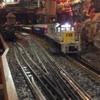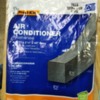For what it’s worth, I have a System, 5/8 plywood, 1/2 homasote, screwed to the plywood, painted a nice green color, (dark browns to), with 1/4 cork road bed under the Atlas/Ross Trackage. I use the Atlas screws and only attach the track to the homasote. I have virtually no noise, no vibration, and I level the track for smooth operation. As far as humidity, my area has very little humidity, but during the summer, we use a dehumidifier. The basement has central heat and air and is a fun place to operate trains. I am not a fan of the foam boards pink or blue. I am a true fan of the model trains with realistic sounds, whistles and bells. Homasote is a compressed paper board and is a bit messy, dusty, but very easy to clean up, and never wears out. If one uses a good jig saw with a fine tooth blade, it’s easy to cut. Happy Railroading. 

















